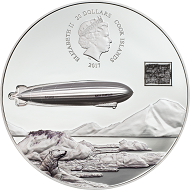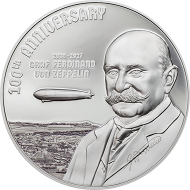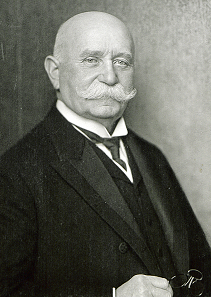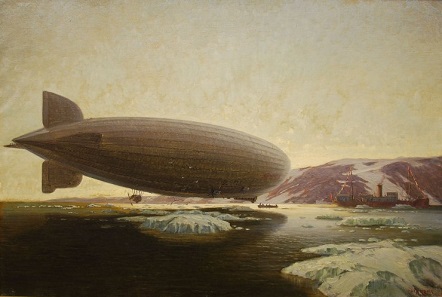April 20, 2017 – The silver edition of the commemorative coin, designed by Coin Invest Trust for the Cook Islands on the occasion of the 100th anniversary of Count Ferdinand von Zeppelin’s death, references two of the most spectacular Zeppelin flights. Each of the 499-pieces limited edition silver coins includes a piece of fabric from the original “Graf Zeppelin”, which was scrapped in 1940. The silver coin is presented in a see-through display case and features an impressively high relief thanks to smartminting© technology.
Cook Islands / 20 Dollars / Silver .999 / 3oz / 50mm / Mintage: 499.
The obverse shows the Ian Rank-Broadley of Elizabeth II, also her name, the title of the issuing nation, and the nominal value. The silver edition additionally features a zeppelin in an Arctic landscape, as well as an original piece of fabric from zeppelin LZ127 in the field on the right.
The reverse features portrait, name, and dates of birth and death of Count Ferdinand von Zeppelin. Also, the inscription 100TH ANNIVERSARY. The silver edition shows the zeppelin flying over a cityscape.
Ferdinand von Zeppelin, 1917. Source: Nicola Perscheid – Staatsbibliothek zu Berlin – Preußischer Kulturbesitz / CC BY-SA 3.0
Count Ferdinand Adolf Heinrich August von Zeppelin was a dirigible pioneer. Born in Constance in 1838, it was in the American Civil War that he first witnessed the use of hot-air balloons, which he even flew himself. This experience inspired him to develop a “dirigible”.
Yet the first attempts, conducted after the end of his military career, failed. That did not only earn him the reputation of “the fool from Lake Constance”, but almost ruined him financially. The turning point only came with the crash of a dirigible in Echterdingen in 1908. The crash of a zeppelin did not mean the financial ruin for the count, but inspired a historic fundraising campaign by the German people, which enabled the continuation of his work and invited identification of Germany with the zeppelins.
LZ 127 with Russian icebreaker Malygin. Painting by Alexander Kircher, 1931.
Zeppelins did more than serve military purposes. They were mainly employed in passenger transportation, even for long distance flights between Europe and the Americas. After the death of its inventor in 1917, the LZ 127 “Graf Zeppelin” was put into operation in 1928. The so-called round-the-world flight of 1929 and the polar flight of 1931 count among its most spectacular flights that covered roughly 1.7 million kilometers in total.
The coins were minted by B. H. Mayer’s Kunstprägeanstalt GmbH. Collectors can purchase the issues through specialty dealers.
Please find more information on these coins here and here.
This is the website of Coin Invest Trust.
To learn more about the LZ 127 Graf Zeppelin, watch this YouTube film Zeppelin’s round-the-world flight in 1929.








